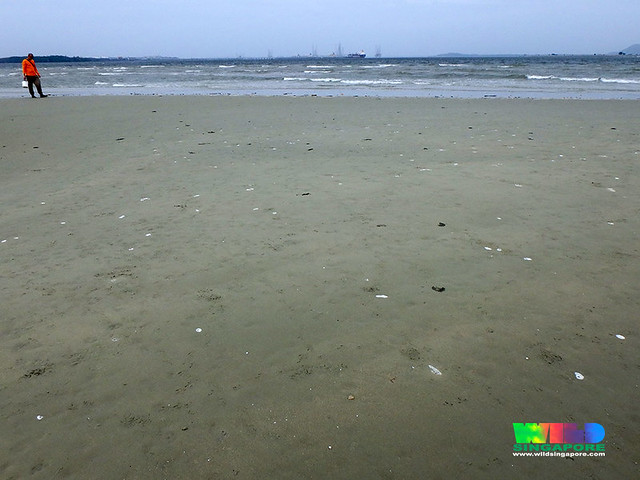We conduct this health check survey once a year, with kind permission from NParks.
It is the Grey bonnet snail, that preys on sand dollars. I was already wondering why we don't see this snail at Chek Jawa's northern sand bar, where their prey is so abundant. We see this snail at Chek Jawa, even at East Coast Park. So it was a lovely surprise to see several of them today.
Another rare snail sighting is of a living Rare-spinded murex by the rest of the team!
And an uncommonly encountered pufferfish.
We last surveyed this shore in Jan 2016, The sandy shores are still very much alive! There were lots of signs of Sand bubbler crabs, Soldier crabs, Straw tubeworms.
The sand bar is teeming with Cake sand dollars. Also many Tiger moon snails from small to large ones. I only saw one Ball moon snail, and one Plain sand star. As in Jan 2016, sadly we didn't come across any living Button snails. Earlier this month, I saw countless Button snails at East Coast Park. I wonder why they are not also thriving at Chek Jawa?
Many shorebirds rely on flats such as Chek Jawa to fuel their long migratory journeys. Here's a feeble photo taken with my point and shoot of what appears to be some Plovers.
Shorebirds also rest on the flats, staying there until the rising tides pushes them away. We tried our best not to disturb them during our survey.
Everywhere, on the sandbar, there are signs of the shore birds. Near their bird prints, sand dollars are flipped over. I've observed this before at Chek Jawa and noticed only some sand dollars are pecked at. Perhaps only those carrying eggs? I also saw tubeworm tubes pulled out of the sand, and the worms pulled out of their tubes.
The birds give back to the shore with poop! Studies have shown that shorebird poop helps seagrasses to grow and heal damaged seagrass meadows.
Among the lively creatures on the shore were these Gold-spotted mudskippers, giving one another The Fin.
Similar to what we saw during our survey in Jan 2016, the seagrasses are growing lush at the northern edge and they seem to be growing into the sand bar from the southern edge.
Seagrasses are also lush in the middle of the Chek Jawa lagoon, the ground there has become rather soft. Spoon seagrass covered large areas, as well as Needle seagrass. I did not come across any Fern seagrass. Smooth ribbon seagrass continue to grow profusely nearer the boardwalk. But I couldn't find any Beccari's seagrass.
Here's a panoramic shot of the shore facing Johor (north). Click on image for larger view.
And a panoramic shot of the shore facing Singapore (south). Click on image for larger view.
The seagrass meadows are dotted with many healthy Haddon's carpet anemones. In 2007, there was mass deaths of Haddon's carpet anemones and other animals at Chek Jawa. This is believed to be due to heavy rainfall as marine life can't cope well with too much freshwater. There are now plenty of Haddon's carpet anemones of all colours and sizes on the seagrass meadows. None of them were bleaching. I also saw one Cerianthid and several Gong gong snails. I didn't see many crabs or even hermit crabs.
There were a lot of Garlic bread sea cucumbers on the sand bar and in the seagrass meadows, from smaller to large ones. There were also some Pink warty sea cucumbers. I didn't come across any other kinds of sea cucumbers. The rest of the team also saw Noble volutes laying eggs. a Spiky sea pen, some small Swimming anemones.
Mangroves fringe the route to the northern shoreline of Chek Jawa. Some of the trees have fallen over or are suffering from erosion. Most of the trees seem fine.
The very rare Critically Endangered Mentigi (Pemphis acidula) is still there and looking alright. We saw under a fallen tree on our last survey in Jan 2016. We also saw a flowering Hoya and other flowering mangrove trees.
As I did in Jan 2016, I had a closer look at the area where the Security Barrier aka fence around the northern shore of Pulau Ubin starts. There is still a great deal of large trash here. From large blue drums, large black plastic objects, abandoned nets, and lots of plastic containers. Here's a view of some of the trash.Similar to our survey here in Jan 2016, On the tip of the northern sand bar facing the Johor River, there was hardly any trash washing up. Only natural flotsam of mangrove leaves, fruits and flowers.
The water was somewhat brownish at Changi Creek, suggesting a possible plankton bloom. We saw and smelled a spill of oil near Ubin Jetty on the way back and saw one dead fish (appeared to be a Needlefish, possibly a victim of recreational fishing?).
Let's hope the water quality stays good and we don't experience another mass fish death.
Posts by others on this trip
- Marcus Ng on facebook.
- Ian Siah on facebook.
- Vincent Choo on facebook.
- Law Ing Sind on facebook.
- Ivan Kwan on facebook.
Others who came on this trip: Mr Kuet, Nicholas Yap, Lisa Lim, Tang Yong Jen.



















